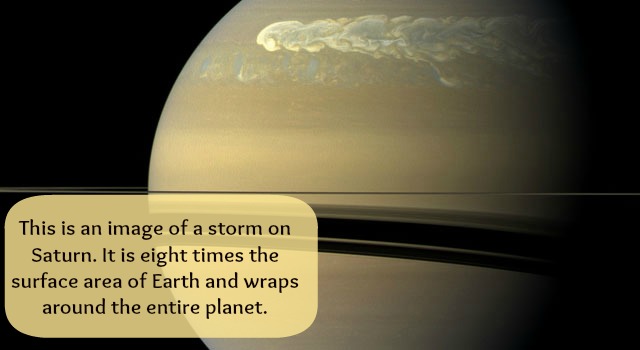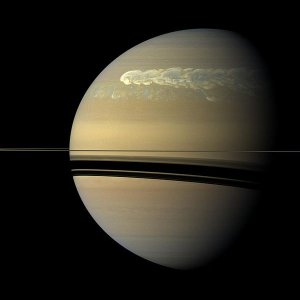

Saturn is the sixth planet from the sun, but in many ways it is a planet of seconds:
- It is the second largest planet
- It is the planet with the second strongest magnetic field
- It has the second largest moon (Titan)
- It has the second fastest rotation (10h 30min)
- But Saturn still is, and probably always will be, number one.
For obvious reasons, Saturn is frequently referred to as “The Jewel of the Solar System.” Although all of the gas giants in our solar system have ring systems, Saturn’s ornaments are, by far, the most awe-inspiring. There are billions of particles that comprise Saturn’s rings; these particles range from dust-sized grains to minor giants (some of which have a diameter of some 1.8 kilometers/1.1 miles). And with a thickness of about 1 km (3,200 feet), the rings span roughly 282,000 km (175,000 miles), which is about three fourths the distance between the Earth and Moon. Moreover, these rings are the only ones that can be seen from the Earth with nothing more than a small telescope. The planet itself is the farthest planet from Earth that can be observed by the unaided human eye.
In many ways, this Saturn puts the Earth to shame. Compare our single measly moon to the 53 natural satellites that have been discovered orbiting Saturn, and we seem paltry indeed. And then there’s the year. As we all know, a year on Earth is 365 days, but on Saturn a year is more than ten-thousand Earth days long. Good advice: if you want to make yourself seem younger, when you tell people your age, measure it in Saturn years…but don’t tell them you’re using Saturn years, obviously (of course, if you are 40, that means that you will be telling people that you are only 1 year old…).
WHAT’S IN A NAME:

Like the other planets, Saturn is named after an ancient God. In this case, the Roman god of farming and agriculture. But farming wouldn’t go so swell on Saturn. In fact, colonizing this beast will probably never be an option. First, you can’t stand on Saturn. It’s not a nice, solid, rocky planet like Earth. Rather, it’s made mostly of gases. So if you tried to land on Saturn, you would just sink into the atmosphere until you were crushed by the immense pressure. Second, like the rest of the planet, the atmosphere on Saturn consists of roughly 75% hydrogen and 25% helium, which means there is little to no oxygen…which means there will be little to no breathing. Third, Saturn is a rather windy place. At the equator, the winds can reach 1,800 kilometers per hour (1,118 mph). With these wind speeds, even if there was oxygen in Saturn’s atmosphere, you still wouldn’t be able to breathe because the air would be sucked from your lungs. Also, the high winds would cause your limbs to flail about like paper in a tornado, which means that most of your bones would probably be pulverized. Couple all of this with the ammonia rich clouds, and this planet makes the Sahara desert seem like a comfortable Hawaiian island.
Oh, and despite its enormous size, Saturn would float in water—which means that the planet is essentially a giant piece of floating jewelry. How can any solar object possibly beat that?